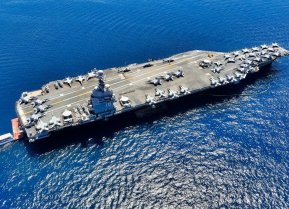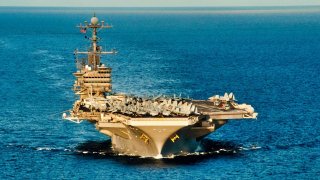The U.S. Navy Could Sail 5 Aircraft Carriers in Pacific as Warning to China
The ability to deploy multiple aircraft carriers to any part of the world remains something only the United States Navy can do – and even as China may have plans for a fourth carrier, it would be hard-pressed to do the same.
Summary: The concept of "gunboat diplomacy" has evolved into what might now be termed "carrier diplomacy," reflecting shifts in geopolitical strategies and military technology. This strategy, deeply rooted in the practice of showcasing naval power to influence or coerce other nations, has been particularly relevant in the context of the United States' approach to its growing competition with China. The planned deployment of five U.S. aircraft carriers to the Western Pacific exemplifies a modern application of this principle, aiming to underscore the U.S. commitment to maintaining a significant presence in the Indo-Pacific region amid China's assertive actions.
The U.S. Navy's Mighty Aircraft Carriers
The term "gunboat diplomacy" originated in the late 19th century to mean the display of military might to force cooperation or the pursuit of foreign policy objectives with the aid of conspicuous displays of naval power. The mere sight of a warship or fleet of ships was meant to have a considerable impact.
Gunboat diplomacy lived on during the Cold War, largely owing to the United States Navy's overwhelming sea power. During his tenure as United States Secretary of State, the late Henry Kissinger summed up the concept stating, "An aircraft carrier is 100,000 tons of diplomacy."
As the United States is increasingly engaged in great power competition with China, it could utilize its carriers in the form of 21st century form of gunboat diplomacy – and perhaps it should be seen as "carrier diplomacy" as it was announced earlier this year that at least five U.S. carriers could be deployed to the Western Pacific this year.
That display of naval power, which would account for nearly half of the U.S. Navy's 11 nuclear-powered supercarriers, is to send a clear reminder to Beijing that it isn't alone in flexing its muscles in the Indo-Pacific.
However, it is important to note that the five carriers won't be lined up – like the often seen footage of Royal Navy warships during the Battle of the Atlantic in the Second World War.
As Responsible Statecraft reported in February, two of the carriers, the USS Carl Vinson (CVN-70) and USS Theodore Roosevelt (CVN-71) had been participating in a military exercise with Japan in the Philippine Sea, while the USS Ronald Reagan (CVN-76) was in port at Yokosuka. The USS Abraham Lincoln (CVN-72) departed San Diego earlier that month, and the USS George Washington (CVN-73) is now expected to relieve CVN-76 in the coming weeks.
In other words, the U.S. Navy is showing that it can constantly maintain a carrier presence in the region.
Stretched Thin
The ability to deploy multiple aircraft carriers to any part of the world remains something only the United States Navy can do – and even as China may have plans for a fourth carrier, it would be hard-pressed to do the same.
The USS Dwight D. Eisenhower (CVN-69) has remained in the Middle East to protect shipping in the Red Sea, while the USS Gerald R. Ford (CVN-78) saw her deployment to the Mediterranean extended twice due to the ongoing Israel-Hamas War. The first-in-class supercarrier has since returned to the United States and will be receiving upgrades to her various systems, which will sideline her for part of the year.
It should be added that the USS John C. Stennis (CVN-74) is currently undergoing her scheduled refueling and complex overhaul (RCOH), which began in 2019 and won't be completed until 2025. The carrier will then have to undergo sea trials before returning to service.
Thus, the United States Navy can rotate more than half of its carriers to the Indo-Pacific, but it limits the ability to send them elsewhere. At any given time, at least one of the nuclear-powered vessels is undergoing an RCOH, while others receive post-deployment maintenance.
China's Gunboat Diplomacy
It is still important to note that the presence of so many U.S. flattops in the Indo-Pacific has coincided with China's years-long territorial disputes with U.S. partners including Japan and the Philippines along the so-called first island chain.
According to a May 2022 report from the U.S. Department of Defense (DoD), "For a decade, China has waged 'gunboat diplomacy' in the South China Sea (SCS) by bullying its maritime neighbors into accepting its territorial claims of 'indisputable sovereignty' and control over 90 percent of the sea. The costs of China's maritime coercion, however, have mounted. Beijing's hostile actions have scuttled its regional partnerships, while bolstering America's relations with Southeast Asian nations."
The U.S. has thus shown its commitment to its regional allies by ensuring that at least one or more carriers are almost always present. There are concerns that this could only further escalate tensions.
There is no denying that China is also seeking to flex its naval muscles, yet as Responsible Statecraft warned, "While these (U.S. Navy) carrier deployments are presumably intended to signal American resolve and commitment to its regional allies, they could easily encourage China and North Korea to engage in their own reciprocal demonstrations of strength. These also a reminder that the U.S. approach to East Asia is still very much a 'military-first' approach that gives short shrift and devotes relatively few resources to economic statecraft and diplomacy."
Author Experience and Expertise: Peter Suciu
Peter Suciu is a Michigan-based writer. He has contributed to more than four dozen magazines, newspapers, and websites with over 3,200 published pieces over a twenty-year career in journalism. He regularly writes about military hardware, firearms history, cybersecurity, politics, and international affairs. Peter is also a Contributing Writer for Forbes and Clearance Jobs. You can follow him on Twitter: @PeterSuciu.
You can email the author: [email protected].
Image Credit: Creative Commons.


